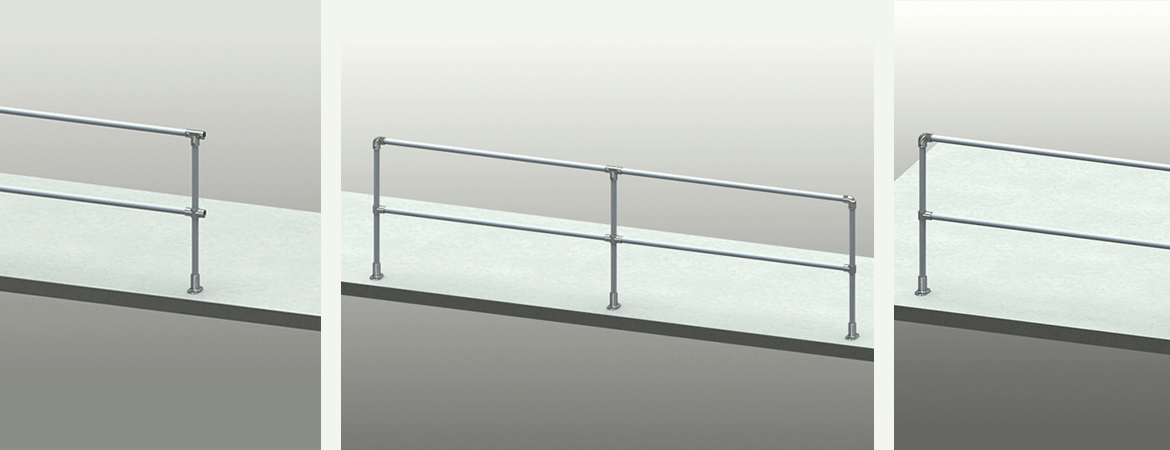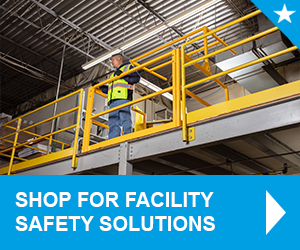
A modular guardrail system can help a variety of industries overcome the drawbacks of permanent guardrails. Because any facility will have unique industrial fall protection requirements, greater versatility is a key aspect of achieving optimal guardrail solutions. Modular rails for equipment, leading edges, or various other purposes increase safety and can potentially fulfill more fall safety compliance requirements.
First and foremost, you must know your fall safety standards by referencing the local, OSHA, or CCOHS codes in your industry. Of course, this may raise as many questions as answers, which is why we’ve compiled some of the most frequently asked questions about modular guardrail systems.
What Makes a Guardrail Modular?
Modularity is extremely useful in designing passive fall protection systems. For leading edges, dangerous equipment, interior openings, and even ground-level barriers, modular guardrails enable safety managers to set and modify durable barriers. They also fulfill various fall protection safety requirements more effectively and alleviate workflows that fixed railing often obstruct.
Modular guardrail construction emphasizes part interchangeability, making it easy to mix and match a range of compatible parts. For instance, shortening a standard rail could take a lot of cutting, grinding, and various custom work. Instead, you can simply replace a vertical modular post with an end piece and reattach the top and midrails to the other side. No burrs or snag risks, and it takes a fraction of the time.
The most reliable and effective modular guardrail system also provides technicians with easy hand-tool installation. Even a single hex key is sufficient to secure some of the most thoroughly engineered modular guardrail products.
Do Modular Guardrail Requirements Have Different Technical Standards?
No, and OSHA’s description of “guardrail systems” (starting at 1910.29[b]) does not designate any type or variety of guardrail products. What they do is ensure fall protection barriers of any variety meet various size and force-testing requirements, while leaving exact construction or design matters to private industry.
Many fall protection equipment manufacturers certify that their equipment meets OSHA standards with testing protocols of their own. While they can’t address every fall safety standard with every product, such manufacturers primarily focus on the most generally applicable technical and quality standards.
As for durability and performance, look for certifications showing a modular guardrail meets or surpasses OSHA force-testing requirements (see 1910.29[b][3] through [5]):
- 200 lbs. (890 N) of force in a downward and outward direction on the top rail
- 150 lbs. (667 N) of force for the same test at the middle rail
Because modular guardrails are known for their customizability, it’s important to confirm any modular railing system (or equivalent component) you’re considering will accommodate the proper dimensions and spacing for each part of the rail. For OSHA regulations, those specifications (1910.29[b][1] and [2]) are:
- Top railing 42 in. (114 cm.) high, plus or minus 3 in. (8 cm.)
- Midrails installed halfway between the top point of the top rail and the walking-working surface
- Top and midrails at least 0.25 in. (0.6 cm.) thick (per 1910.29[b][9])
- Vertical members a maximum distance of 19 in. (48 cm.) apart
- Openings for intermediate members also no more than 19 in. (48 cm.)
So long as they meet your region’s and industry’s fall protection safety standards, modular guardrails are an effective option anywhere the facility or worksite uses standard guardrails.
How Effective Are Modular Guardrails?
A modular railing system is much more effective than standard fixed rails because they promote:
- User-friendliness
- Easy adjustment
- Due diligence by staff, and avoidance of workarounds
- Less interference with workflows
- Compatibility with many other fall protection devices
- Customizability for non-standard space or layout requirements
- Ability to fulfill a wider range of industrial fall protection needs
When Are Modular Guardrails Better Than the Alternatives?
Modular guardrails fulfill a range of accessibility requirements not always possible with alternatives. For instance, an opening in a wall or hole that requires railing may be adequately covered at a later point, when the railing becomes no longer necessary. Areas like hoists or machines require easy access, sometimes on demand.
Most generally, as your operations scale up, so too will your space requirements. Even for small, incremental changes, modular rails for equipment must expand to accommodate larger equipment in need of OSHA machine guarding.
Further, you’ll be able to quickly take your safety railing with you if you move facilities. Modular rails store easily, and as we’ll explore next, their fast disassembly/assembly and part interchangeability makes a range of solutions possible.
How Can You Configure Modular Guardrails?
A modular railing is often part of a larger product line with components that are easy and quick to install. In addition to your choice between permanent and portable systems, modular guardrails make the following types of configurations possible:
- Straight divisions across a surface
- Non-standard lengths to reach openings, tight corners, or oddly-positioned equipment
- Vertical builds, such as for tall equipment
- Dual guardrails to create pathways (e.g., along catwalks or to guide people away from potentially dangerous industrial equipment, ladders or stairways, etc.)
- Custom-length barriers in mezzanines and other storage areas that must be accessible and protected
It’s also possible to build enclosures and control access using innovative safety gates, including:
- Self-closing gates
- Universal hinge mount gates
- Bolt-on mounts (compatible with round or square tubing, angle or flatbar, directly into a wall, and a variety of other locations)
- A variety of widths, including various adjustment ranges on most models
- Vertical lift safety gates
- Different heights and widths, including full vertical coverage
Along with their adaptability, safety gates come in a range of unique colors, finishes, and materials. When combined with a modular guardrail system, the two make an unlimited range of configurations possible.
Contact Fabenco for More Answers to Your Modular Guardrail Questions
In any work environment where guardrails are a permanent fixture, workflow and future fall protection safety concerns will be affected by their location and impact on movement. Rather than allow fixed designs to limit your workforce, choose a modular guardrail system and ensure your passive fall protection equipment adapts to you.
Combined with equally adaptable safety gates and other fall protection devices, you’ll have location-independent solutions to a broad variety of fall safety requirements. If you have any questions about modular rails for equipment, elevated walkways, leading edges, and other applications, contact Fabenco – a global leader in industrial fall protection solutions for over 45 years.





